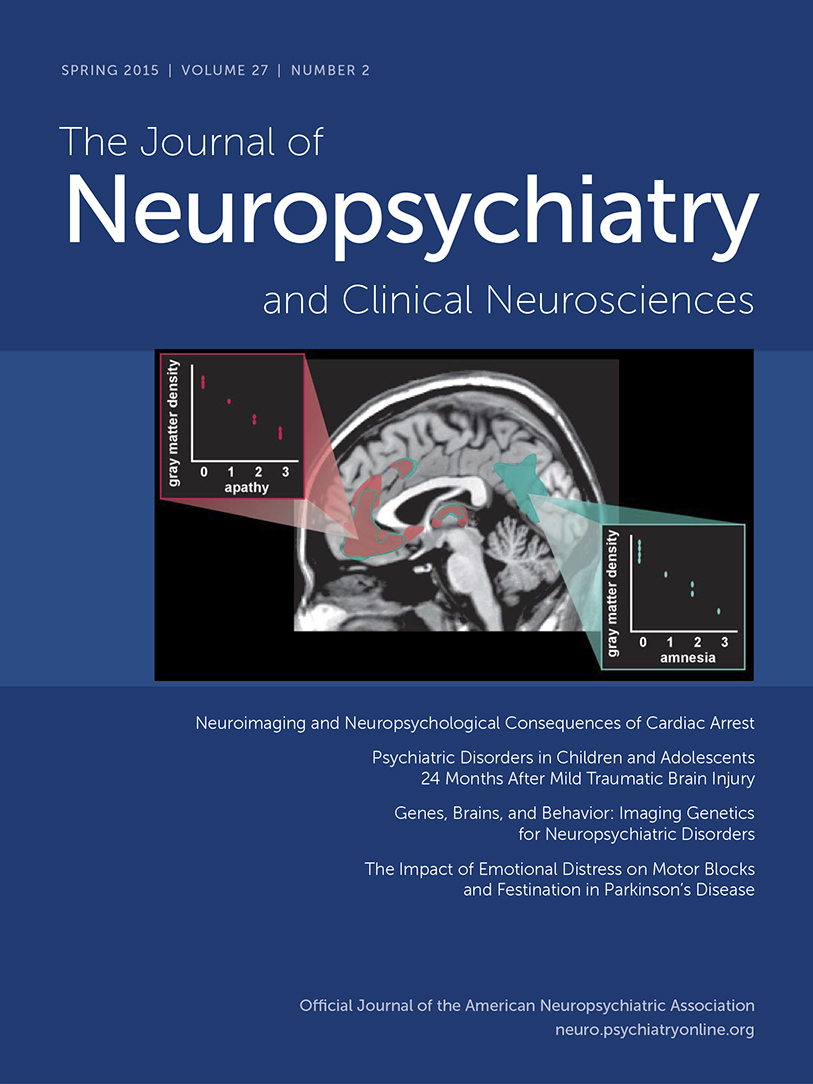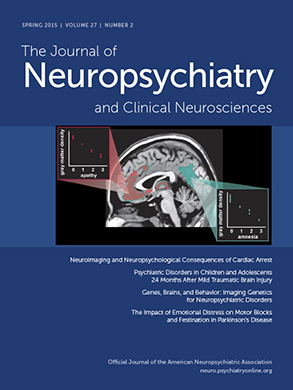Neuropsychiatric symptoms occur in more than one-half of patients with SLE.
1–4 The American College of Rheumatology has identified five neuropsychiatric syndromes associated with SLE, including psychosis.
1 Catatonia, recognized by
DSM-5 as a symptom domain of psychosis, is characterized by disorganized motor behavior and decreased ability to respond appropriately to environmental cues. Patients with catatonia demonstrate social withdrawal, mutism, bizarre posturing, and motor immobility or excessive movement.
5 There are rare reports of patients with SLE developing catatonia. These patients are at increased risk of developing pulmonary emboli and cerebrovascular accidents secondary to immobility.
6–9To our knowledge, no studies have compared treatment modalities of catatonia associated with SLE; however, high doses of benzodiazepines, electroconvulsive therapy, and plasma exchange have been shown to be effective.
6,7,10–12 We describe a patient with SLE who presented with paranoid delusions, abnormal behaviors, and motor immobility and was determined to be catatonic. Her symptoms resolved with lorazepam 1 mg i.v. and were kept in remission with lorazepam 1 mg p.o. three times daily. This is the first report of a patient with catatonia associated with SLE to be effectively treated with low doses of oral benzodiazepines.
Case Report
A 21-year-old woman with recently diagnosed SLE was brought to the hospital by her parents for abnormal behaviors. For 1 week, she had been expressing paranoid thoughts that her neighbors were watching her. She had also begun to hear voices that were conspiring against her. For the previous 3 days, she had become increasingly withdrawn. She spoke only a few words at a time and moved slower than normal. She was afraid to sleep at night and instead walked throughout the house, turning on appliances. Her parents were concerned that she could no longer care for herself and brought her to the emergency department. She was evaluated by the psychiatry department, placed on an involuntary hold for grave disability, and admitted to the medicine service for further evaluation.
One month earlier, the patient developed a malar rash and oral ulcers. She was found to have leukopenia and a positive antinuclear antibody test and was diagnosed with SLE. Her symptoms improved with intravenous steroids, and she was discharged home on prednisone, hydroxychloroquine, and mycophenolate mofetil. Her parents confirmed that she had been compliant with her medications since discharge. Before her diagnosis of SLE, the patient had been in good health and worked in a hair salon. She occasionally smoked cannabis but had no other drug use. She had no history of psychiatric illness.
During the interview, the patient was conscious but minimally verbal and did not respond to questions. On examination, she was afebrile and other vital signs were within normal limits. Her eyes were able to track slowly and vacantly fixed on objects. She made no other spontaneous movements. There was increased tone in her upper and lower extremities and hyperreflexia throughout. She stood if assisted from the bed; however, she would not move forward or return to a seated position unless assisted. The remainder of her neurologic examination was normal. She had no skin or joint findings, and her examination was otherwise unremarkable.
Laboratory analysis showed a white blood count of 5.8×109/L, a hemoglobin level of 11.9 g/dL, and a platelet count of 204×109/L. Her basic metabolic panel and vitamin B12 and folate levels were normal, and serologic testing for syphilis and HIV was negative. Antinuclear and anti–double-stranded DNA antibodies were positive, and she had low levels of C4. Antiribosomal P protein antibody was negative. Urine toxicology screen was negative, and CSF analysis was unremarkable. A noncontrast CT scan, MRI scan, and single photon emission computed tomography scan of the brain were normal.
The patient was started on olanzapine, but her psychotic symptoms did not improve. Before a lumbar puncture, she was premedicated with lorazepam 1 mg i.v. and incidentally became conversant and changed into a gown independently. However, the following morning, she had regressed to her previous state. Based on the patient’s withdrawal, mutism, motor retardation, and stupor, she was diagnosed with catatonia, thought to be secondary to SLE. In addition to her home medications, she was started on lorazepam 1 mg p.o. three times daily. The following day, the patient was conversant and walked about the hallways at a normal pace. Her involuntary hold was removed by the psychiatry department. She underwent cyclophosphamide pulse therapy and was continued on prednisone and hydroxychloroquine for her SLE. On discharge, she was continued on lorazepam for 3 months and thereafter on clonazepam 0.5 mg p.o. daily as an outpatient. Eight months after discharge, she has had no recurrence of her catatonia or other psychotic symptoms.
Discussion
SLE is an autoimmune disorder affecting multiple organ systems, including the central, peripheral, and autonomic nervous systems. In 1999, the American College of Rheumatology identified 19 neurologic syndromes associated with SLE, including five neuropsychiatric syndromes: mood disorders, psychosis, cognitive dysfunction, anxiety disorders, and acute confusional state (delirium).
1 Neuropsychiatric symptoms occur in 50%−70% of patients with SLE and may be the presenting manifestations of the disease or may occur at any time during its course.
1–4 The pathogenesis of neuropsychiatric symptoms in patients with SLE is unclear and may be secondary to direct brain injury from SLE, indirect effects from nonspecific inflammatory process, concomitant primary psychiatric disease, iatrogenic effects of steroids, or psychosocial stress of having a chronic illness.
13 Neuroimaging may assist in the diagnosis and monitoring of neuropsychiatric syndromes associated with SLE; however, the diagnosis of neuropsychiatric SLE remains a clinical one.
Psychosis overall is uncommon in SLE and occurs in <10% of patients with SLE.
14 Patients with SLE who develop psychosis usually do so in the first year of their SLE diagnosis and may present with paranoid delusions or audiovisual hallucinations, causing significant distress and social impairment. Psychosis at the onset of SLE is associated with disease activity, and is associated more with positive antiphospholipid and ribosomal P antibodies than cutaneous or renal manifestations of SLE.
14,15 It is important to identify and treat patients with SLE who develop psychosis, because these patients are at increased risk of developing other central nervous manifestations of SLE, such as strokes and seizures, and psychotic symptoms typically remit with treatment of the underlying SLE.
14Catatonia, although not included in the American College of Rheumatology nomenclature of neuropsychiatric syndromes associated with SLE, is recognized by
DSM-5 as a symptom domain of psychosis, traditionally associated with schizophrenia. It is characterized by a decreased response to environmental stimuli and either decreased or excessive/bizarre motor activity. Patients may demonstrate social withdrawal, mutism, stuporous appearance, odd posturing, waxy flexibility, excessive purposeless psychomotor movement, or mimicking of behaviors.
5 Catatonia is most often linked to psychosis and mood disorders, but can also be associated with neurologic, toxic, infectious, and other medical conditions.
5 In a recent review of the literature, Grover et al.
6 identified 22 case reports of patients with SLE who developed catatonia, including patients whose initial presenting symptom of SLE was catatonia. Some investigators propose that the diagnosis of catatonia can be made if an empiric intravenous dose of benzodiazepine resolves a majority of a patient’s catatonic signs. It is important to diagnose and treat the underlying cause of catatonia, because patients with catatonia are at increased risk of developing malnutrition, pulmonary emboli, and cerebrovascular accidents secondary to immobility.
6–9To our knowledge, there are no controlled trails comparing treatment modalities of catatonia in patients with SLE. Previous reports have shown that high doses of oral and intravenous benzodiazepines can be effective. Wang and Huang
10 described one patient who improved with a single dose of diazepam 20 mg i.v. and another patient who improved with diazepam 30 mg i.v. daily for 5 days. Brelinski et al.
7 described three patients with SLE who presented with catatonia that resolved with lorazepam 10–15 mg p.o. daily. Grover et al.
6 described a patient who improved with lorazepam 8 mg p.o. daily. Given the risks of tolerance, dependence, and overdose with high doses of benzodiazepines, our experience suggests that dose response should be considered in the treatment of SLE with catatonia. Electroconvulsive therapy and plasma exchange are also shown to be effective treatments of catatonia associated with SLE.
11,12 In addition to treating catatonia, it is also important to treat the underlying SLE and to avoid any medications that may induce catatonic- or SLE-like symptoms.
In summary, the diagnosis of catatonia should be considered in patients with SLE presenting with psychotic symptoms. Treatment should be initiated early to prevent neurologic complications, including stroke and seizure, as well as complications from immobility, such as pulmonary embolus. To our knowledge, this report is the first to demonstrate that catatonia associated with SLE may be effectively treated with low doses of oral benzodiazepines.

